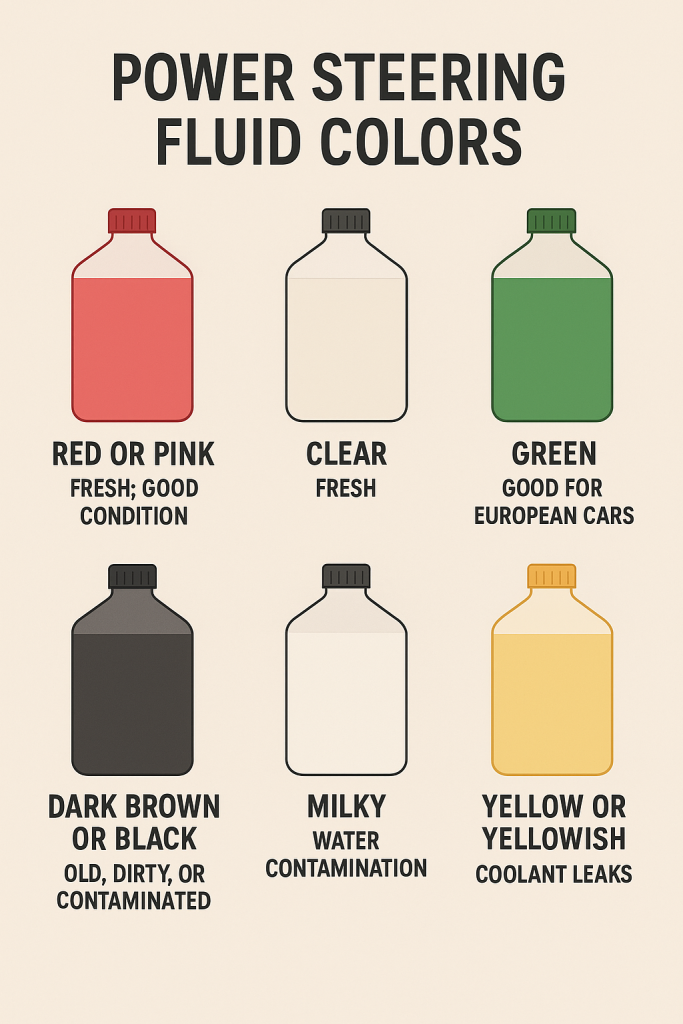Power steering fluid color can give you important clues about your vehicle’s steering health. Fresh fluid is usually red, pink, green, or clear, depending on the car model. However, if the fluid looks dark, milky, or foamy, it may signal contamination or problems in the system.
Understanding these colors can help you know when to check or replace the fluid. This Power Steering Fluid Color Chart will guide you on what each color means and how to maintain your steering system in good condition.
What Is Power Steering Fluid?
Power steering fluid is a special hydraulic fluid used in a vehicle’s power steering system. It helps create a hydraulic link between the steering wheel and the front wheels, making it easier to turn the wheels with less effort.
The fluid also lubricates and protects moving parts, preventing wear and corrosion. Power steering fluid usually comes in colors like red, amber, pink, or clear. If the fluid becomes dark, milky, or foamy, it may need to be replaced. Using the correct fluid type is important for keeping the steering system working smoothly and safely.
Power Steering Fluid Color Chart and Meanings
Power steering fluid comes in different colors, mainly added by manufacturers to help identify the type. The power steering color chart also helps show the fluid’s condition and if the steering system is healthy.

- Red or Pink: These are the most common colors for fresh power steering fluid. They indicate that the fluid is clean and working properly. Red fluid is often compatible with automatic transmission fluids.
- Clear: Some power steering fluids are clear. This is normal for certain fluid types and shows the fluid is fresh.
- Green: Found mostly in some European cars like BMW and VW, green fluid is a special type and should not be mixed with red fluid.
- Dark Brown or Black: Fluid that looks dark or black means it is old, dirty, or contaminated. This fluid cannot lubricate the system well and needs to be changed.
- Milky: Milkiness means water has mixed with the fluid, which can damage the power steering system. It needs urgent attention.
- Foamy or Bubbly: Foamy fluid means air is trapped in the system. This can affect steering performance and usually means there is a leak or loose hose.
- Yellow or Yellowish: A yellowish fluid can be a sign of coolant leaks mixing with the steering fluid. It needs to be flushed to avoid damage.
How to Check Power Steering Fluid Level and Color
Checking your power steering fluid colors is easy and helps keep your steering smooth. Follow these simple steps.
Warm Up the Fluid
Start your car and let it run for a few minutes. Then, turn the steering wheel fully to the left and right several times. This warms the fluid and gives a more accurate reading. Turn off the engine before checking.
Locate the Reservoir
Open your car’s hood and find the power steering fluid reservoir. It’s usually a small container near the engine, often with a black cap and marked label. Some reservoirs are clear plastic, others are metal.
Check the Fluid Level
If the reservoir is clear plastic, look at the fluid inside to see if it is between the “MIN” and “MAX” lines on the container. If it has a dipstick in the cap, remove the cap and wipe the dipstick clean. Then reinsert and remove it again to check the level. The dipstick usually has marks to show low, full, or acceptable fluid levels.
Check the Fluid Color
Look at the fluid on the dipstick or inside the reservoir. Fresh power steering fluid is usually red, pink, amber, green, or clear. If the fluid looks dark, black, milky, or foamy, it may be dirty or contaminated and needs changing.
Add Fluid if Needed
If the fluid level is low, add the right type of power steering fluid little by little until it reaches the full mark. Do not overfill.
Finish Up
Securely close the reservoir cap. Always check your car’s owner manual for the correct fluid type and maintenance advice.
ATF vs Power Steering Fluid: Key Differences
Power steering fluid is a special liquid that helps make steering your car easier. It works by creating hydraulic pressure in the steering system, reducing the effort needed to turn the wheels. The fluid also lubricates parts and prevents damage. Different fluids have different colors, showing their type and condition. Checking and maintaining the right power steering fluid is important for safe and smooth driving.
| Feature | Automatic Transmission Fluid (ATF) | Power Steering Fluid |
| Primary Use | Lubricates and cools automatic transmissions | Provides hydraulic pressure and lubrication for steering |
| Color | Usually red or amber | Typically red, pink, amber, green, or clear |
| Composition | Contains friction modifiers, detergents for transmission | Focuses on viscosity and lubrication for steering system |
| Heat Resistance | Lower flash point (~400°F) | Higher flash point (500-600°F), better at withstanding heat |
| Additives | Includes detergents and friction modifiers | May have fewer detergents, more focused on hydraulic function |
| Viscosity | Thinner for smooth transmission shifts | Slightly different viscosity to suit steering pump |
| Interchangeability | Sometimes used in power steering if manufacturer allows | Usually not suitable for transmissions |
| Common Types | Dexron, Mercon | Synthetic fluids, mineral oils, and sometimes ATF types |
| Manufacturer Recommendation | Must follow vehicle manual specifications | Must use specified fluid type per manufacturer’s guidance |
| Risk of Incorrect Use | Can cause transmission damage or failure | Can cause steering system damage or poor performance |
While some vehicles use ATF as power steering fluid, these fluids are formulated differently for their systems. Always check your owner’s manual before substituting fluids to avoid damage.
Power Steering Fluid Change Interval and Maintenance Tips
Power steering fluid should generally be changed every 30,000 to 50,000 miles or every 2 to 4 years, depending on your vehicle and driving habits. Some cars have specific manufacturer recommendations, so always check your owner’s manual first.
When to Change
- If the fluid looks dark, dirty, or smells burnt, it is time to change it.
- Unusual steering noises or difficulty turning can also signal fluid problems.
- Vehicles used in tough conditions (offroad, towing, city stop-and-go) may need more frequent changes.
Maintenance Tips
- Check fluid level and condition at every oil change.
- Top off fluid as needed but avoid overfilling.
- Inspect for leaks and damaged hoses regularly.
- Flush the entire system during fluid changes to remove old debris.
- Replace fluid after major steering repairs to protect the system.
Regular maintenance helps avoid wear and costly repairs. Clean power steering fluid keeps the steering smooth and the system lasting longer, ensuring safe driving.
Conclusion
Power steering fluid color is a useful indicator of your vehicle’s steering system health. Fresh fluid is usually red, pink, clear, or green, showing that it is clean and working well. If the fluid becomes dark, milky, or foamy, it usually means the fluid is old, contaminated, or there is a problem like water or air in the system.
Regularly checking the fluid color helps you catch issues early and maintain smooth steering. Always follow your vehicle’s recommendations for fluid type and replacement to keep your steering safe and reliable.
FAQs
Can You Mix Different Colored Fluids?
No, you should not mix different colored power steering fluids. Different colors often mean different types, and mixing them can cause damage or reduce the fluid’s performance.
What To Do If You Notice A Leak Color?
If you notice a colored leak, check your power steering fluid level and color. Identify the fluid type, clean the area, and visit a mechanic to fix the leak quickly.
How To Identify Power Steering Leaks By Color?
You can identify power steering leaks by their color. Red, pink, or clear fluid under your car usually means a power steering leak that needs checking immediately.


